|
|
|
The Saber-toothed Cat of the Northsea
|
|
|
|
Authors: Dick Mol, Wilrie van Logchem, Kees van Hooijdonk en Remie Bakker.
Publisher Drukware, Norg.
ISBN nr. 978-90-78707-03-5
|
|
|
|
Steppenwisent
|
|
 |
|
|
|
Design for a steppenwisent, to be realised in 2007 in 3-D, for Twentse Welle, the new museum in Enschedein het eastern part of The Netherlands. In this museum will be showed the collections of Museum Jannink, the Natuurmuseum and the so called oudheidkamer.
|
|
|
|
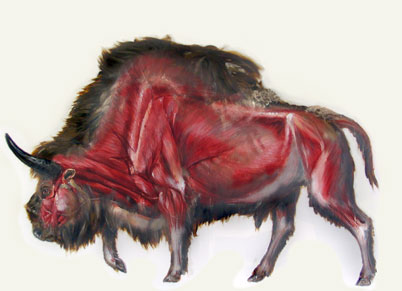 |
|
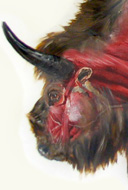 |
|
|
More Mammoth !
|
|
|
|
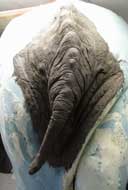 |
|
|
|
In the end of 2004 Manimal Works was asked to build a model of an mammoth. The team that had found the Discovery-Channel mammoth found a new and better preserved mammoth in Russia in 2001. This animal must be the example for the new model that is now built for the world-EXPO 2005 in Nagoya, Japan. The model is build to give the visitors of the world-EXPO 2005 in Nagoya, Japan.The model is build to give the visitors of the EXPO 2005 an idea of how a mammoth must have looked. The building is in progress and the model must be transported to Japan on February 20 2005. There the tusks are casted and fused with the model and the hair is put on. The model will be 283 centimetres at the shoulders. The scientific supervision is in the hands of Dick Mol. He was present at the excavation of the Yukagir mammoth and knows this animal. His help is vital to make this the Yukagir mammoth instead of an average mammoth.
|
|
|
|
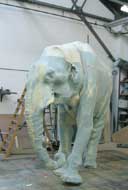 |
|
|
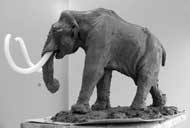 |
|
 |
|
|
 |
|
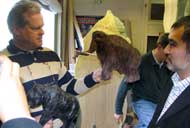 |
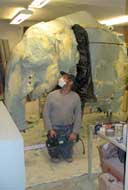 |
|
|
 |
|
|
Unveiling beetlesculpture
|
|
|
In Leuven (Belgium) the artwork "Totum" by Jan Fabre, and carried out by Manimalworks is unveiled on 26 October 2004 at the marktplaats (MainSquare). A large Beetle has been placed on a needle of 27 meters high. The real scarabee beatles are only 4 centimetres large.
|
|
|
|
a real Sternocera laevigata
approx. lifesize
|
|
|
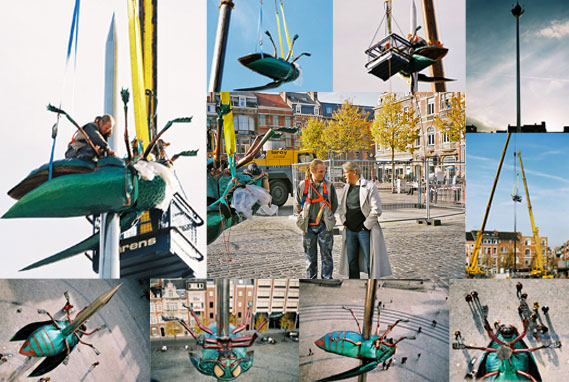 |
|
|
|
REMIE'S WEBlog: travel dairy Kathanga
|
|
|
Every now and then you can
be lucky enough to be offered
a job that is really special.
This job was exactly that.
I was asked to make a replica of
a block frozen sand that is carved
free of the Siberian tundra.
Why a block of frozen sand?
|
|
|
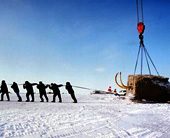 |
|
|
fromthe discoverychanneldocumantairy
photo:dirk hoogstra
|
|
|
This block contains the mortal remains of a mammoth (Mammuthus primigenius) this is preserved in the ice for ±20.380 years. When they found the remains of this animal they decided to cut around the carcass to take it to a controlled environment and do research on the remains later. The excavation and the transport (by helicopter) is filmed and broadcasted by the discovery channel. This is why most people know this animal (named the “Jarcov mammoth- after the family that has found it) as “the discovery channel mammoth”.
The block, itself, is a timecapsule in his own right. If they had excavated the block then it would have revealed many secrets about this animal’s life and death. The great scientific treasure of this project is the frozen environment around the mammoth. If you excavate the animal, this will bee destroyed. It will be contaminated with resent material, decay and lose its context. In the condition, where it is kept in now, you can take accurate uncontaminated samples of the world in witch the animal has lived loved and died.
|
|
|
|
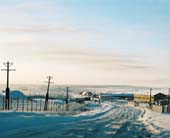 |
|
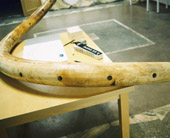 |
|
 |
|
|
Kathanga
|
|
original mammothtusk
|
|
interior airplane
|
|
|
|
Now the model of a block looks just like any other………block nothing special. What makes this block special and gives it identity are the tusks.
The best way to capture the shape of these tusks is to cast them only…..They can not leave Russia. This leaves one option…I will have to go to Russia. I was invited to cast the tusks in Khatanga, I think I have made the most northern silicone moulds in Russia as yet (at least for me it was)
In the time before I had to go to Russia, it became very clear very fast that I could not get all the materials to Khatanga without contacts and experience. My Client, on the other hand, did have all this experience sins the core business of CERPOLEX (run by Bernard Buigues) is; the realisation of polar expeditions. They could bye most of the materials in Russia itself. A happy fact what made import, and so custom- forms and contact not required.
The voyage itself was done in several stages.
The first step was to go to Moscow. There I met with a group of ; three taxi-drivers, two polar travellers, a guide and the wife of my client (Silvie). From Moscow international airport we had to go to the national airport “Doremethevo” . This meant that all the people and an impressive pile of baggage tat to go in to the tree cabs and drive, over the ring of Moscow.
At Doremethevo we had to wait fore the plane and everyone (with the exception of me and one of the polar travellers) had to find/search/bye ore pick something up in Moscow. So ..we waited fore everyone to return while we guarded the pile of material and waited on the boss ( Bernard Buigues) so he could find us and add his pile of baggage to ours. This took ± 4/5 hours and everyone found one another, at least 5 minutes before the plain would leave.
|
|
|
|
 |
|
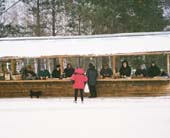 |
|
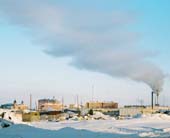 |
|
|
Bernard Buigues
|
|
shoppingmall in
doppuladidvuadoworzow
|
|
Khatanga
|
|
|
|
Late in the evening we flew to Krarsjorjarsk in a plane that, clearly, was build in the 80 s (because it looked like something from the 70’s) and was kept in the air ever sins. It was interesting to see that the rug, in the aisle, was reattached to the flour with simple nails to prevent people tripping over it.
We arrived in Krarsjorjarsk at ± 5.00 AM and had to travel by bus to the next airport for the connecting flight. (The pile of baggage had grown so big that we used a truck to get it moved to the airport).
The terminal was……empty and cold. Nothing would lead you to believe that this was going to be an airport in the next 10 years, but is was.
More material had to be found and 5 people stayed with the baggage while the others went away. (By now the pile was so big that you needed more people to make sure that nothing would disappear when it will become busy in the future) So it was cold and desolate but at least the ground did not move and so most of u tried to sleep some.
After a few hours the rest came back and seemed to be happy that they could make the pile even bigger than before. I must say that it became increasingly crowded and the people that had to way the pile baggage became ever so friendly when the had finished their job. They seem to know Bernard and know that, when he comes, the chance that they will get paid this month is getting bigger.
Around 10.00 AM. , After the final checking of the tickets, we where invited to come to the VIP launch to have a drink and a small snack. I am a cynical person by now and I think it was mainly to make sure that we would not chance our minds about some heavy items in the baggage. A few snacks are a small price to pay to make sure that the money for the execs baggage is paid. I do not know how they did it but all the baggage was loaded in the small propeller plane together with 24 people two pilots and a stewardess.
|
|
|
|
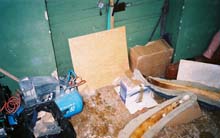 |
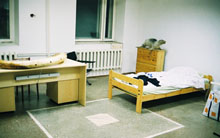 |
|
|
|
workshop
|
|
Mij sleepingroom (wiht stuffed seal on the nighttable)
|
|
|
The small plane looked like a strong small workhorse and the inside reminded me of a small 60’S caravan interior. The same one people in my town had in the garden for the kind to play in. Every now and then you see them in barnyards, as henhouse.
At this time I was happy to have bought earplugs, not that the other passengers made a noise but the sound at the takeoff can be deafening.
Regardless of how the planes look, the pilots are fantastic. I have seen them take off and land on runways covered with ice so slippery that I would fall over in my car. (This could also tell you something about my driving skills)
The first part, east, took ± 5 hours but felt longer. You can not talk to you the person next to you and I tried to ignore the dead animal on his head. Most people spend this time reading or sleeping, What can you do? This all seems like nagging but the hole trip was a real adventure (for me it was, being the first time there) When we landed to refuel we came in a small town were the people had made a wooden stand to sell local products to the people that were passing through. This tow did have a name but it did not stick in my mind. It might have sound like “ doppuladidvuadov” but it, also, might have been “doppuladidvuovithc”. They had a cantina where they sold Coca-Cola, liquor, soda’s, Coca-Cola, jam, liquor, Coca-Cola, pretzels, liquor, and parts of fruit and vegetables. At the stands outside they sold caviar, jam, frozen fish and evergreen branches for in the sauna. After a brake we went back to the plane to move up North. This part also took ± 4,5 hours and I had enough time to think about the fact that: when you see a machine the first time (say a car) it looks very impressive. If you see it the second time; you start wondering about the fact that you did not notice small defects the first time. I wondered how often I would dare to get out and in this plane??
The plane lands and in the darkness, there it is: Khatanga !! It was cold when we got out of the plane and there was snow on the ground. This must be as I imagined Siberia. To bad it was dark and we had to wait until the next morning to see the town.
|
|
|
|
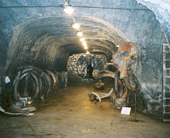 |
|
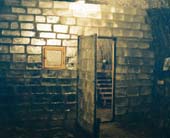 |
|
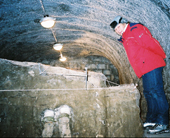 |
|
|
permafrostgrotto
|
|
permafrostgrotto
|
|
The smell of mammoth
|
|
|
|
Khatanga
This town is in the centre of the tundra and there are two options of getting there ( I excluded walking in these options)1= by plane . 2= by boot. You can sail the Khatanga river 4 of the 12 months per year. This is how the bulk of the materials gets there; by boot
The town is build for ±10.000 people but when Peace broke out and the government did not fear an attack of the Americans over the pole, all the military airforce personal was send home. This leaves a population of ± 4000 people. Almost all of the inhabitants of this “ghost town” work, ore are connected to, the airfield and maintaining this important polar gateway. The main road runs parallel to the river and starts out of nothing and ends in nothing. In between there is the town of Khatanga.
This is Russian Siberia.
The thing is; all the people look clearly European but there are so many things different. This makes you feel like you have leaped into time, back to our Europe in the 50’s. Than you add up the fact that ±50% of the buildings are still wood and many houses are empty.
I was brought to my room. This was one of the rooms in a space that is used as a lab and museum in an old government building.
People that have worked in different places know that the work is no different, it is the surroundings and the circumstances that make the difference. There is also a challenge in working with materials that you doe not know. You see; not every silicone is the same and there is always the possibility that material; doe not work, are to old, are incompatible, useless, frozen ore simply not enough ore not up for the job.
I could not work in the lab, It does not seem smart to work with silicones and resins and sleep in the same place. There was one other room that could be heated and used to make the moulds: The toolshed. A room of 4 by 4 with a steel door and some heating. Hey what will you choice bee?? The shed it was.
So I spend most of my time bend forwards over the tusks building the separationwalls, putting on the silicone , heating it extra with a hairdryer, building up epoxy resin layers and so on. I had to use epoxy because the hardener fore polyester is tot to be transported by aeroplane. Epoxy comes real close in the amounts that have to be mixed and no one seen to be able to tell me what the mixingratio’s where. (A reply by the salesman of …”ehhhh ….. probably 2:1 ore something” does not help)
All the materials I used had to make a chemical reaction in order to doe what they are supposed to do. The temperature is very important in this reaction. I was lucky, in this respect, that it did not get very could …yet. At night the temperature dropped to -10ºC. It seems to drop to –45 in January. The coldest I have experienced there was -24ºC but that was the last days only.
Like I say, cold does funny things to materials. I found out that the epoxy stays thicker and does not flow away so fast. This does mean that it penetrates the fibres not that good and the layers of glass do not bond as well as they should. When you put tension on this material it will splinter, come lose in layers and brake like glass, quite fast. What it did do, to my surprise, is; stick to silicone?!!?? Very……….interesting.
|
|
|
|
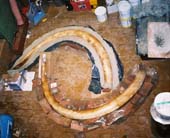 |
|
 |
|
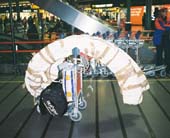 |
|
|
Tusks in the mould
|
|
workshop
|
|
Amsterdam Airport
|
|
|
f you work long hours you see unusual things (not just because you are tiered). I was fortunate enough to see the aurora borealis. An endless ribbon of green high in the sky in an unbelievable display. You do not realise how big it is until you see it. If you do see it, it is hard to believe.
What strikes you up there is the independence of the people that live there. They all doe some building and rebuilding and try to make sure that they have enough food for the winter. I can not say if the grow crops (I am sure the do not, due to the short summer and the permafrost in the ground) but they do hunt. You will se a lot of snowmobiles pulling sleds stacked with reindeer carcasses. In the winter they are stored in seacontainers next to the house but in the summer the are stored in the manmade caves under the town where the permafrost keeps it -10ºC all year round. In these caves are not only reindeer and fish but also …iceage mammals and … a Mammoth. The same permafrost that kept the mammoth preserved fore more than 20.000 years is still preserving it now. One part of the cave is filled with bones and tusks of mammals and mammoths that once lived in this area.
It is really odd that if you are close enough to the block and the fur is heated slightly, you smell the animal as if you smell an elephant in the zoo.
There I met my firs mammoth, covered with ice crystals. These form on everything out of the breath of visitors and evaporated water by excavating the block and using lightbulbs in the cave.
I hope that the model I made gives everyone something of the magic of the cave and the excitement of the answers and questions that lay in the contents of the block. It is a frozen piece of time waiting to tell the tale.
The trip back was a mirrorimage of the trip to Khatanga only, with a smaller pile of baggage and two moulds of 3 meter long that had to be moved. The Russians did not blink if they must transport this odd kind of stuff. As long it is not real mammothivory. It was harder to convince the KLM of the fact that I did want to take these ….things back to Holland.
All things together, will I do it again?? Just tell me where and when!!!!
|
|
|
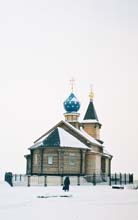 |
|
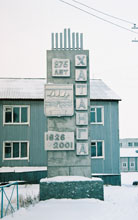 |
|
|
|
 |
|
|
Lucy at the "Apenheul"
|
|
|
|
For the "Apenheul" in Apeldoorn, we made a reconstruction
Lucy, the famous in 1974 found skeleton of an ±4 milion year old lady.
|
|
|
|
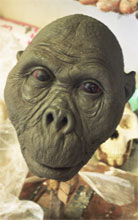 |
|
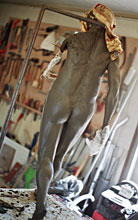 |
|
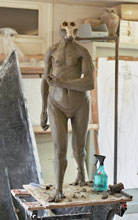 |
|
|
The set-up of Lucy in clay.
|
|
|
|
 |
|
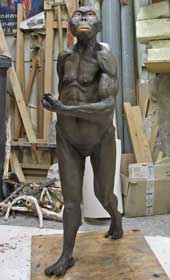 |
|
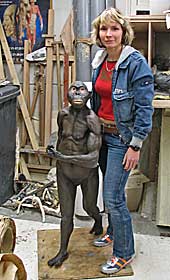 |
|
|
The model of Lucy is here still under construction, and will soon receive her hair/fur
|
|
|
|
|
|
|
|
|
|
|
|
|
|
|
|
|
|
|
|
|
|
|
|
|
|
|
|
|
|
|
|
|
|
|
|
|
|
|
|
|
|
|
|
|
|
|
|
|
|
|
|
|
|
|
|
|
|
|
|
|
|
|
|
|
|
|
|
|
|
|
|
|





















